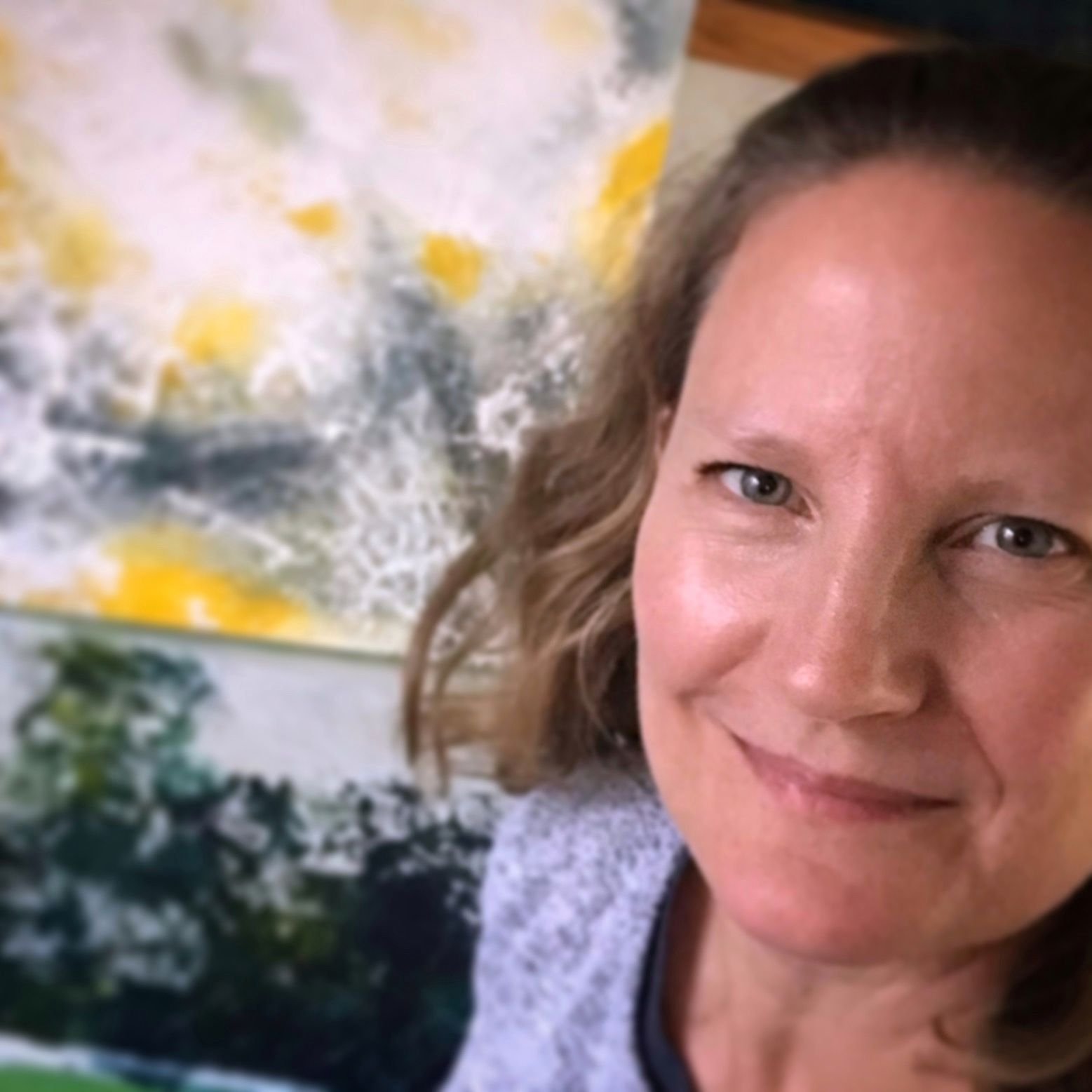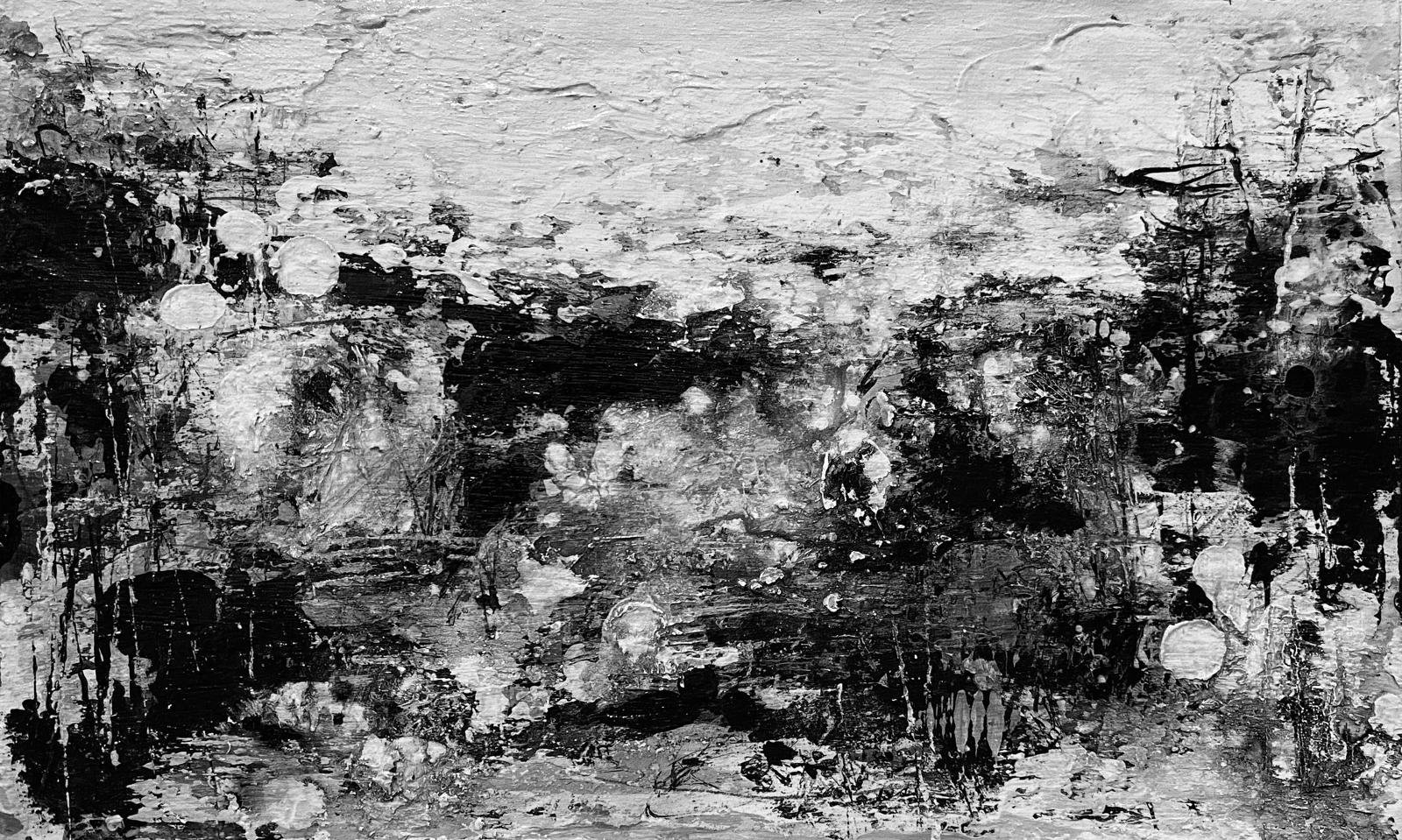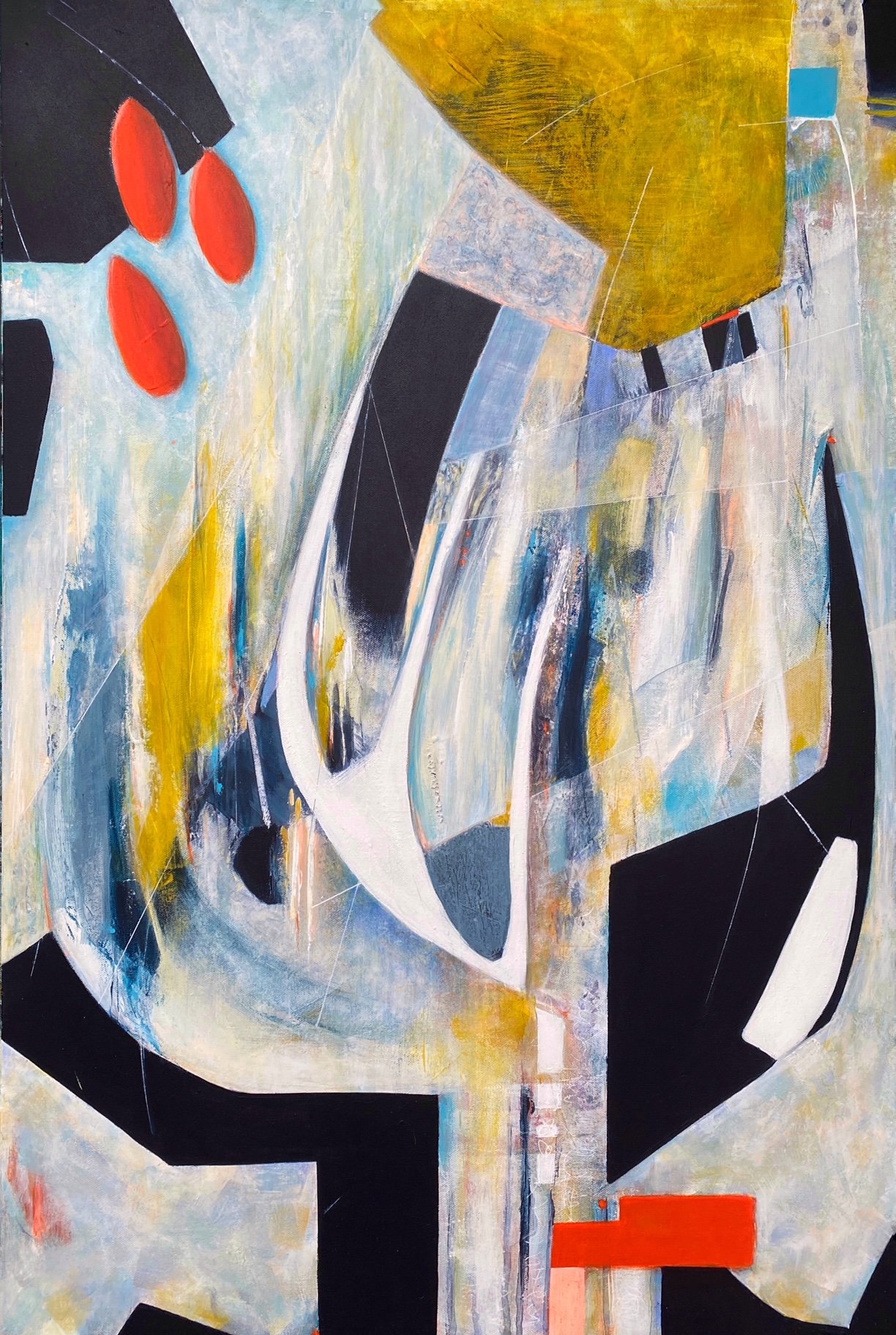Lisa Larson Lee
What media of art do you work in?
Paint. Primarily, I work in acrylics and often incorporate various texture mediums, found objects, and metal leaf in my work.
How would you describe your genre of painting?
Abstract expressionism—I follow my muse to create intuitive, abstract art on canvas, paper, and panel.
Can you describe your creative process? When you begin a painting, do you have an idea of what the end result is? Do you prepare sketches first? Do you know the colors you are going to use?
That’s a tough one because it never seems to start—nor finish—the same way twice. My work is process and exploration based so, unless I’m working on a series, each piece is unique. I do have favorite colors (e.g., brights and neons) that make reappearances.
I might sketch an idea with the intention to use it as the basis for a new piece but it rarely makes its way onto the canvas. Over time, these ‘thumbnail’ drawings have become a guide for working out proportions, line, and color.
To begin a piece, I break the daunting white of a canvas or panel with some wild, gestural marks or sweeps of paint. Some artists say they struggle to make their first marks on a blank substrate but I’ve never had a problem there: if anything, I swing too wide and have to narrow focus afterward.
Typically, I’ll set down multiple colors in thick layers so that I can dig into them while they’re wet and again later when they’ve dried. Setting down texture (paint, mediums, paper, or found objects) gives me something to respond to as I work, and into which I can scrape and scratch, or sand down to reveal color and shape that are layers deep. I admit that I’ve ruined a few canvases when I’ve gotten carried away using a palette or X-Acto knife.
What is the message you want people to take away from your artwork?
While painting, I explore shape, movement, texture, and color. I keep joyful feelings, memories of favorite places, or meaningful words (poem, prose, lyrics)—or people that I’m making commissions for—in my mind. My aim is for my inspiration to be captured abstractly in the work, and hopefully that translates for the viewer. I want people to connect with my work through their sensory response to it, or memories that it might evoke, so that they can see or take from it something personal to them. Often their unique interpretations help me to see my pieces in new ways, too.
100 years from now, how do you want people to remember you as an artist?
This is a great, and a dangerous, question to ponder.
It would be grand to be remembered for creating a strong, dynamic oeuvre that explored new techniques and captured something in the genre that no one else had or could—and for perhaps even breaking a barrier or two along the way.
I’d like to imagine retrospectives of my work held at museums and galleries, and that it would be honored under the banner of artist not woman artist—because in 100 years’ time I’d like to think that our work and careers, collectively, will not be prefixed by gender (e.g., woman artist, woman astronaut, woman race car driver).
This question is dangerous, too, because I believe that if we set out to be remembered then we risk following the wrong muse: meaning, work that’s created by an artist who is driven by external reward or recognition is, in my view, vastly different from the work of an artist that’s guided from within. To me, it’s important to stay true to one’s artistic vision; without that internal compass, one can find oneself lost easily in pap or conformity.
What is your favourite praise you have received from a client or about your work?
From clients, it’s the smiles when a piece is finally theirs, and “I love it!” “It looks fab on the wall!” “I walk past it every day and keep loving it.” That feedback gives me the warm fuzzies. I’m so grateful to my clients for trusting my process and for keeping a piece (sometimes more) of me in their home or work space and close to their hearts.
From followers, some of my favorite comments are about composition and structure, and when the viewer understands what I was trying to achieve: “I love it… I see and feel your strength and power and nerve!” “The lines and movement on this piece are so strong and gorgeous.” “Absolutely love this painting! The depth, layering, composition and colors are fantastic.” And a personal fave: “This is pretty freakin’ cool.”
What are your hobbies outside of Art?
I enjoy the calm and strength-building of yoga, and I really enjoy it when a walk, hike, or bike ride finds me headed for home.
I’ve not thought of it as a hobby, per se, but I was the interior designer and draftsperson for four of our home renovations in Singapore, including kitchens, bathrooms, and hard furnishings. Early in life, after I’d dismissed graphic artist as a calling, I’d considered furniture design. I haven’t put that idea to bed yet. That said, I might have to embroider the old adage ‘measure twice, cut once’ on a throw pillow because it took me several tries before I calculated correctly the kitchen layout dimensions of my current home.
What is an interesting piece of trivia about you that people don’t know?
I’ve jumped out of two perfectly good airplanes. The first time was solo from 2K feet above Beiseker, Canada, and the last was from 10K feet with a man strapped to my back above Townsville, Australia. Neither time went entirely smoothly, so I’ve decided that three times won’t be the charm.
Give me one or two sentences about your family?
I met my Singaporean husband while traveling in Bali, and later I left Canada to marry him. Singapore is homebase but we’ve been fortunate to have had two overseas assignments: California, outside of San Francisco in the East Bay; and London UK. Our wonderful child was born in California.
What has been your strongest influence in your art career thus far?
By 2019, I’d long left corporate life and had been making art casually for four years. I had sold several pieces and started to exhibit my work in Singapore. Then I moved to London and had to rebuild my art community from scratch. Just before the pandemic hit, I signed on for two, three-month intensive art course back-to-back. The courses focused my intentions for my work and style, offered advice on how to start and grow an art business and, through their associated artist group communities, I learned more about various art processes and the practicalities of small business hustle. The learning was valuable, but the artist communities and artist friends I’ve made since have become invaluable.
What is your vision for yourself as an artist 5 years from now?
That my work has continued to grow in strength, style, and recognition. That I continue to take risks creatively, to say “yes” to exciting opportunities that come my way, and to build deep connections with and opportunities for other artists in my community. In five years, I’d like to look back to see that my work has been featured frequently in solo, regional, and international shows, that I’ve had the honor to attend interesting artist retreats abroad, and that my work is featured in galleries and in print, and even on textiles—I’ve always wanted to see my abstracts on silk.
Which one is your favorite artwork you have ever done and tell us why?
I don’t have a fave, per se, but there are a some pieces in particular that come to mind when I think back on work I’m just a little bit (OK, a lot) in love with. One is a small black and white piece that I made in late 2020 on a page in a terrible novel that I’d turned into a sketchbook. The piece (not the novel) is dense with mark making and tone. It’s an abstracted forest, and features many elements that I enjoy in my work: imagined places, high contrast, and varying textures, shapes, layers, and lines. I used palette knives, Posca pens, and a bit of brushwork. I’ve always enjoyed working small because the whole ‘canvas’ is within easy reach, and even tiny additions/edits can have a big impact. Also, elements appear more pronounced; for instance, one can see easily the areas where I’ve played with a recurring motif of what I call ‘pods’ in a variety of shapes, thicknesses, and tone.
Untitled; 5x7”, acrylic and mixed media on paper.
Which is one of your most recent works?
“Don’t Lose Your Nerve” is a dynamic piece that I created in Spring 2023. The underlayers were colorful and frantic and changed repeatedly as I moved paint in wild strokes across the canvas. It was a true flow-state piece: the main organic forms found shape on their own and, thereafter, I teased forward and pushed back sections of strong hue and pastel, added soft marks, and finally defined bold, grounding elements in deep violet. There are three fiery orange ‘pods’ in this piece that form a natural, balanced trinity, and their soft curves float effortlessly above the angular discourse below.
“Don’t Lose Your Nerve”; 24x36”, acrylic and mixed media on deep-edged gallery stretched canvas




